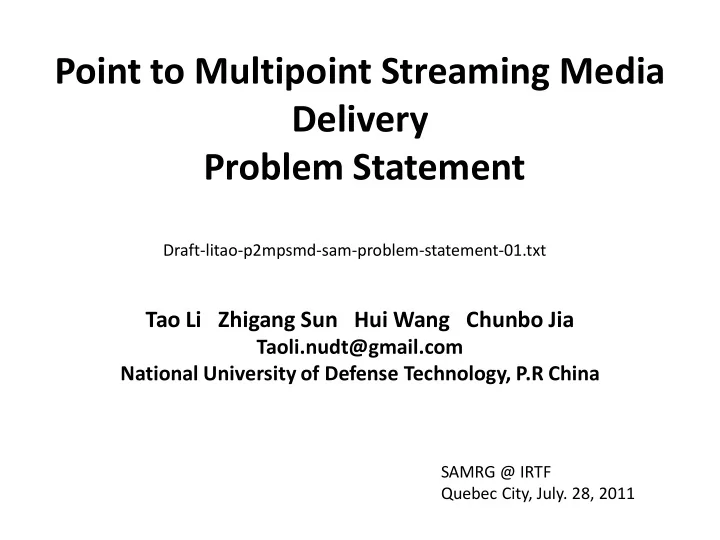

Point to Multipoint Streaming Media Delivery Problem Statement Draft-litao-p2mpsmd-sam-problem-statement-01.txt Tao Li Zhigang Sun Hui Wang Chunbo Jia Taoli.nudt@gmail.com National University of Defense Technology, P.R China SAMRG @ IRTF Quebec City, July. 28, 2011
Recall • Challenges Facing P2MP Streaming Media Delivery High QoE (end-users) Optimized resource utilization (ISPs) Efficient and low-cost deployment, maintenance and management (ISPs/ICPs) • Major Problems Network state information (NSI) acquisition Policy-based control (Separation between mechanism and policy)
Changes from last version • Several editorial improvements • More discussion on the existing technologies • Ongoing work and preliminary experimental results (in this presentation)
Existing Technologies for P2MP Streaming Media Delivery • IP multicast (SSM) • RTP/RTCP extensions + SSM • Application-level overlay (P2P, CDN)
IP Multicast (SSM) Network resource (Bandwidth ) efficiency Complete Standard protocol architecture Problems: Scalability for maintaining state information Commercial implementation support (Accounting, group management, Security)
RTP/RTCP extensions + SSM Error resilience Monitor and fault isolation More delicate control Problems: Real-time Accuracy
P2P Robustness and resilience Scalability Easy Deployment Problems: Profit of ISP Management and resource optimization
CDN Reliability Manageability Safety Problems: Cost Scalability
Experiments • Exp-1 : Network state information (NSI) acquisition – Real-time monitoring – Accuracy locating • Exp-2 : Policy-based Control – Flexibility – Adaptive
Experimental Setup ( Exp-1 ) Labelcast Router Stream 1 Stream 2
Experimental Results ( Exp-1 ) DF Value: Delay factor (Normally 5~20) (a) R3: DF and MLR (b) R3: DF and VBR (Virtual Buffer Rate) Real-time and accurate information of network impairments Labelcast provides data-plane NSI Independent of control plane or upper layer protocol
EXP-2: Parameterized Gradient Based Multicast Routing (PGBMR) • Objective An adaptive multicast routing mechanism supporting parameterized policy-based p2mp streaming media delivery • Motivated by PGBR [“An Evaluation of Parameterized Gradient Based Routing With QoE Monitoring for Multiple IPTV Providers”, ITOB 2010]
EXP-2: Parameterized Gradient Based Multicast Routing (PGBMR) PGBR [“An Evaluation of Parameterized Gradient Based Routing With QoE Monitoring for Multiple IPTV Providers”, ITOB 2010]
EXP-2: PGBMR Experimental Setup = αϕ + β + γ G ( ) t ( ) t l ( ) t h → → u v s d , , v u v v s d , , i i Different parameters allow for the different polices (a) n=100 (a) n=200
EXP-2: PGBMR Experimental Results .5 .5 KPP KPP Jia Jia Our algorithm, α=0.3,β=0.3,γ=0.4 Our algorithm, α=0.3,β=0.3,γ=0.4 .4 Our algorithm, α=0.2,β=0.2,γ=0.6 Request blocking probability .4 Request blocking probability Our algorithm, α=0.2,β=0.2,γ=0.6 .3 .3 .2 .2 .1 .1 0.0 0.0 10 20 30 40 50 10 20 30 40 50 Group size Group size Comparison of Request blocking probability 1100 1600 KPP KPP Jia 1000 Jia 1400 Our algorithm, α=0.3,β=0.3,γ=0.4 Our algorithm, α=0.3,β=0.3,γ=0.4 Our algorithm, α=0.2,β=0.2,γ=0.6 Our algorithm, α=0.2,β=0.2,γ=0.6 900 Average total tree cost Average total tree cost 1200 800 1000 700 800 600 600 500 400 400 300 200 10 20 30 40 50 10 20 30 40 50 Group size Group size Comparison of total cost of multicast tree From “Greedy Gradient Based Multicast Routing Policy for Dynamic Network, ICMT2011”
Remarks • NSI is essential for real-time monitoring and accurately locating the impairment of the network. • Policy-based control for flexibility is feasible to be implemented by separating the policies from the mechanism .
Comments or questions?
Recommend
More recommend